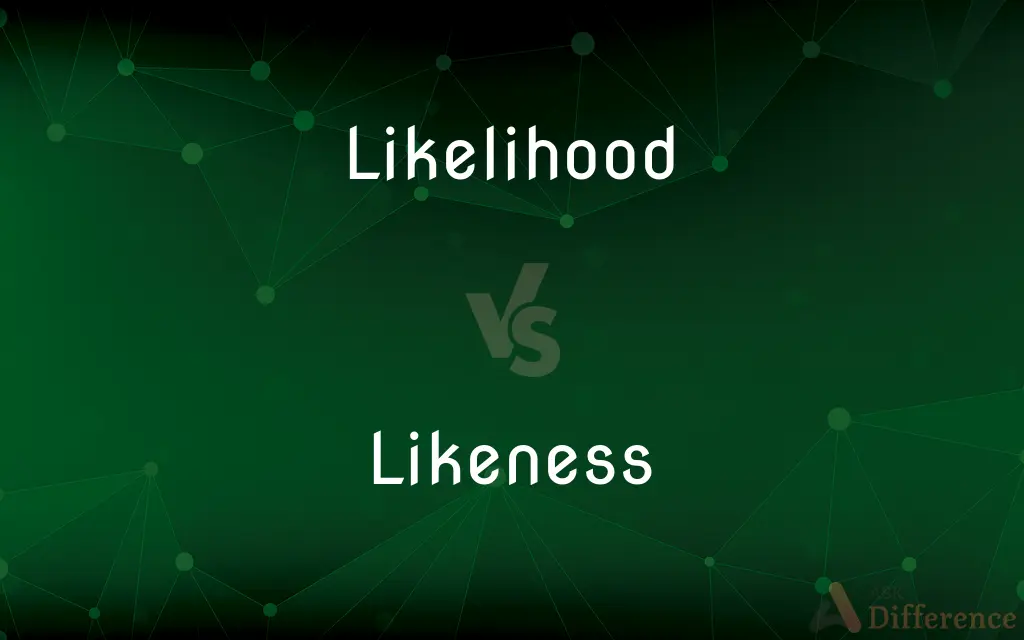Likelihood vs. Likeness — What's the Difference?
By Maham Liaqat & Fiza Rafique — Updated on March 16, 2024
"Likelihood" denotes the probability of an event occurring, whereas "likeness" refers to the resemblance or similarity between things or persons.

Difference Between Likelihood and Likeness
Table of Contents
ADVERTISEMENT
Key Differences
"Likelihood" pertains to the chance or probability that a specific event will happen, often used in contexts where outcomes are uncertain. It is a concept rooted in probability and statistics, guiding decisions and forecasts in various fields. "Likeness," on the other hand, is concerned with the degree of resemblance or similarity between entities, highlighting qualities or features that make one thing look or seem like another.
When discussing "likelihood," one often considers factors that influence outcomes, such as conditions, past events, or statistical data, to evaluate the probability of future events. In contrast, "likeness" involves comparing characteristics, appearances, or behaviors to identify similarities, often used in art, literature, and everyday comparisons to express how closely things resemble each other.
The application of "likelihood" is prominent in areas like risk assessment, where understanding the chances of different scenarios is crucial for making informed decisions. "Likeness" finds its application in contexts requiring visual or conceptual comparison, such as identifying family resemblances or drawing analogies between disparate concepts.
Moreover, "likelihood" is a quantitative concept, often expressed in numerical terms or qualitative descriptions of probability, such as "likely," "unlikely," or "highly probable." "Likeness," however, is qualitative, focusing on the qualitative aspects of comparison without necessarily quantifying the degree of similarity.
Despite their differences, both terms can intersect in discussions about scenarios or simulations, where the "likelihood" of certain outcomes may be assessed based on their "likeness" to known situations or models, blending probability with comparative analysis.
ADVERTISEMENT
Comparison Chart
Definition
Probability of an event occurring
Resemblance or similarity between entities
Context
Used in evaluating chances and making predictions
Used in comparing appearances, qualities, or behaviors
Application
Risk assessment, forecasting, decision-making
Art, literature, identification, analogy making
Nature
Quantitative, often expressed in probabilities
Qualitative, focuses on similarities and resemblances
Example Use
Assessing the likelihood of rain tomorrow
Noting the likeness between family members
Compare with Definitions
Likelihood
In statistics, a measure of the fit of a statistical model to a sample of data.
The model's likelihood increases with the accuracy of its predictions.
Likeness
The state or quality of being similar or alike.
The likeness between the twins is uncanny.
Likelihood
The probability or chance that something will happen.
The likelihood of rain this afternoon is high.
Likeness
Likeness can also refer to a semblance or appearance that resembles something else.
The clouds took on the likeness of a dragon.
Likelihood
Likelihood can also refer to the state of being likely or probable.
Given his skills, his likelihood of winning is considerable.
Likeness
The term is used in photography and digital imaging to refer to the accuracy of a representation.
The photographer's skill brought out the true likeness of the landscape.
Likelihood
In casual usage, it can simply mean the quality of being likely.
The likelihood of misunderstanding each other was evident.
Likeness
In art, a representation of a person, especially in the form of a statue or painting.
The artist captured her likeness in the sculpture with remarkable accuracy.
Likelihood
The term is also used in legal contexts to assess probabilities.
The judge considered the likelihood of the defendant's story being true.
Likeness
In legal and privacy contexts, "likeness" can refer to one's image or persona.
The lawsuit was about the unauthorized use of his likeness in the advertisement.
Likelihood
The state or fact of something's being likely; probability
Situations where there is a likelihood of violence
Young people who can see no likelihood of finding employment
Likeness
The fact or quality of being alike; resemblance
Her likeness to him was astonishing
A family likeness can be seen in all the boys
Likelihood
The state of being probable; probability.
Likeness
The state, quality, or fact of being like; resemblance.
Likelihood
Something probable.
Likeness
A similar appearance; a semblance.
Likelihood
The probability of a specified outcome; the chance of something happening; probability; the state or degree of being probable.
In all likelihood the meeting will be cancelled.
The likelihood is that the inflation rate will continue to rise.
Likeness
A pictorial, graphic, or sculptured representation of something; an image.
Likelihood
The probability that some fixed outcome was generated by a random distribution with a specific parameter.
Likeness
The state or quality of being like or alike
Likelihood
Likeness, resemblance.
Likeness
Appearance or form; guise.
A foe in the likeness of a friend
Likelihood
(archaic) Appearance, show, sign, expression.
Likeness
That which closely resembles; a portrait.
How he looked, the likenesses of him which still remain enable us to imagine.
Likelihood
Appearance; show; sign; expression.
What of his heart perceive you in his faceBy any likelihood he showed to-day ?
Likeness
To depict.
Likelihood
Likeness; resemblance.
There is no likelihood between pure light and black darkness, or between righteousness and reprobation.
Likeness
The state or quality of being like; similitude; resemblance; similarity; as, the likeness of the one to the other is remarkable.
Likelihood
Appearance of truth or reality; probability; verisimilitude.
Likeness
Appearance or form; guise.
An enemy in the likeness of a friend.
Likelihood
Statistical probability; probability of being true or of occurring in the future; as, the likelihood of being abducted by aliens is close to zero..
Likeness
That which closely resembles; a portrait.
[How he looked] the likenesses of him which still remain enable us to imagine.
Likelihood
The probability of a specified outcome
Likeness
A comparison; parable; proverb.
He said to them, Soothly ye shall say to me this likeness, Leech, heal thyself.
Likeness
Similarity in appearance or character or nature between persons or things;
Man created God in his own likeness
Likeness
Picture consisting of a graphic image of a person or thing
Common Curiosities
How does context affect the interpretation of likelihood?
The interpretation can vary with context, such as in weather forecasting versus gambling, where different factors and data are considered.
Can the likelihood of an event be precisely measured?
Yes, in many contexts, especially with sufficient data, the likelihood can be quantified using probability theory.
How is likelihood used in decision-making?
Likelihood helps in evaluating the chances of various outcomes to make informed choices based on probable scenarios.
How do cultures influence the concept of likeness?
Cultural perceptions can influence what is considered a likeness, especially in art and literature, where interpretations can vary widely.
Is likeness always related to physical appearance?
No, likeness can also refer to similarities in characteristics, behaviors, or abstract qualities.
Can two unrelated things have a likeness?
Yes, unrelated entities can share likenesses in appearance, structure, or concept, often used metaphorically or symbolically.
Does a high likeness ensure identicality?
High likeness implies strong resemblance, but it does not mean that the entities are identical; minor differences can still exist.
Can the likelihood change over time?
Yes, as new information emerges or conditions change, the likelihood of an event can increase or decrease.
Are there tools to measure likeness?
While there are tools and techniques in fields like digital imaging and facial recognition, likeness is often assessed subjectively in everyday contexts.
Can likelihood and likeness be used together analytically?
Yes, in scenarios like predictive modeling, where the likeness of current conditions to historical data can inform the likelihood of future events.
Share Your Discovery

Previous Comparison
Doll vs. Dull
Next Comparison
Stranger vs. XenodochyAuthor Spotlight
Written by
Maham LiaqatCo-written by
Fiza RafiqueFiza Rafique is a skilled content writer at AskDifference.com, where she meticulously refines and enhances written pieces. Drawing from her vast editorial expertise, Fiza ensures clarity, accuracy, and precision in every article. Passionate about language, she continually seeks to elevate the quality of content for readers worldwide.














































